When I came across these stunning Mark Catesby prints, I knew I had to share them. They are some of the most beautiful vintage natural history illustrations that I have ever come across.
It’s amazing to think they were made in the early 18th century. The prints are from his famous book “The natural history of Carolina, Florida and the Bahama Islands” published in two volumes (1731-1743).
In the natural history field this is a very important book, as it was the first to be published on the flora and fauna of North America.
Mark Catesby (1683- 1749) was a British Naturalist. When his father died in 1912, he inherited enough money to live on without having to work. So he decided to accompany his sister to Virginia America, where her husband was working.
During this time Catesby also visited the West Indies before returning to England in 1719. He brought back many seeds and botanical samples.
Due to the success of these seeds and botanical samples with gardeners and botanists, Catesby returned to North America to Carolina for a plant-collecting expedition in 1722. He even had a few plants named after him.
Mark Catesby & The Natural History of Caroline, Florida & The Bahamas
From his experience of his time in America, Catesby published two volumes of his book. Which were the main texts on the natural history of America for over 100 years.
At the time of publication, the books were famous for introducing Europeans to new species of plants and animals that were only found in the Americas.
As well as being stunning pieces of art, the books still have scientific importance today. They highlight a number of species that have either disappeared or become very scarce since.
Another unusual thing about the book was that it was the first time that birds and other animals were drawn in the environments that surrounded them, such as the trees they nested in or plants they fed on. Catesby was also the first to discover bird migration.
Catesby’s book, when first published, was well received by the Royal Society. At the time it was thought of as the most magnificent publication the Society had seen. His work greatly influenced many future naturalists, such as John James Audubon.
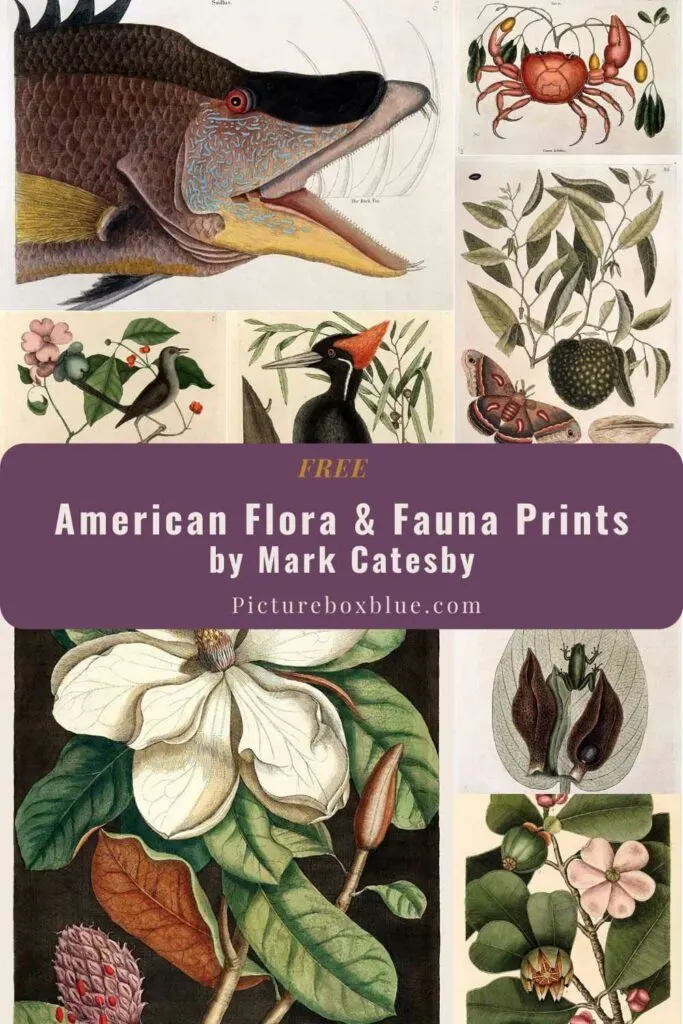
How To Download The Natural History Prints
Click on the title above the vintage illustration that you want to download. A larger version of the Mark Catesby prints will then open as a new window in your browser. If you right-click on that image with your mouse, you will have the menu option to save it to your device.
1. Carolina Moth with Fruit
This Mark Catesby print and many of the following are from the Welcome Collection.
An illustration showing the largest Carolina moth (Phalaena magna) with Anona maxima, a fruit resembling the custard apple. This tree fruit is food to iguanas and other animals inhabiting the Bahama Islands, on which they grow.
The abdomen of the Carolina moth is encompassed by five rings of muddy red color, the eyes are large and spherical. In the middle of every wing is a large red and white spot.
One-third of the lower part of every wing is bordered with alternate stripes of white, red, yellow, black, and brown. The further corner of the two upper wings has each an oval black spot, which is a semi-circular white mark.
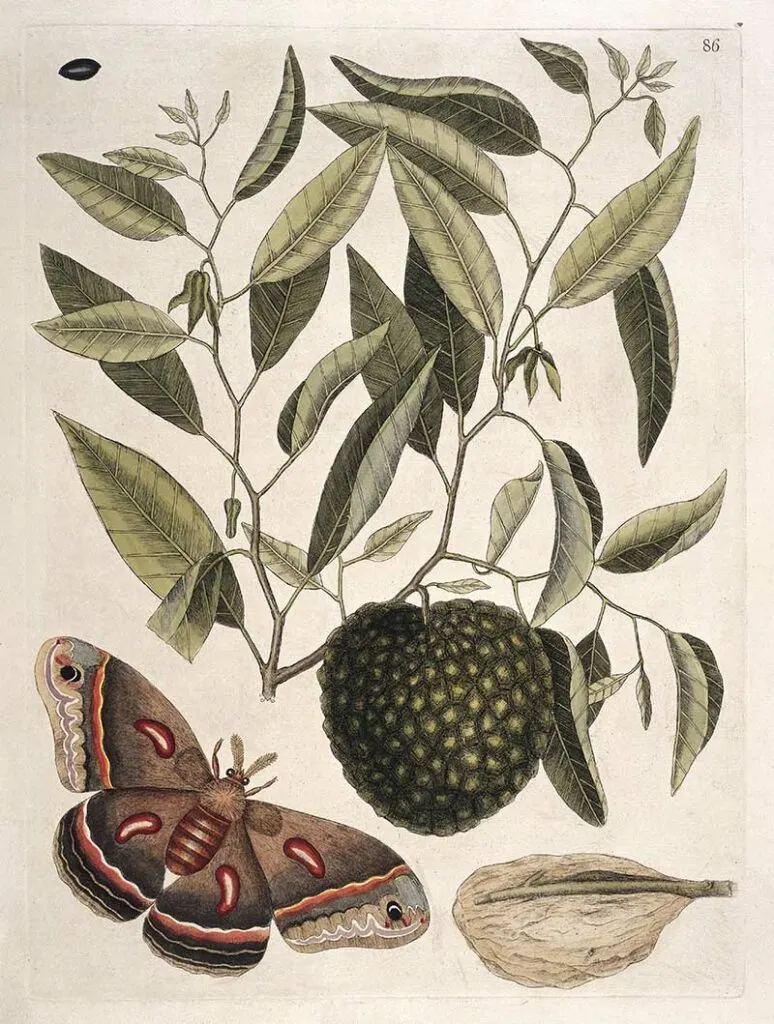
2. Globe Fish
A print showing a Globe fish (Orbis laevis variegatus) with Cornus foliis salicis and An Phaseolus plants.
The Globe fish has a small mouth, near which the eyes are placed, and behind them two small fins. The tail fin is forked. The upper part of the body is of an olive color, marked with many irregular curved white stripes; the belly dusky white.
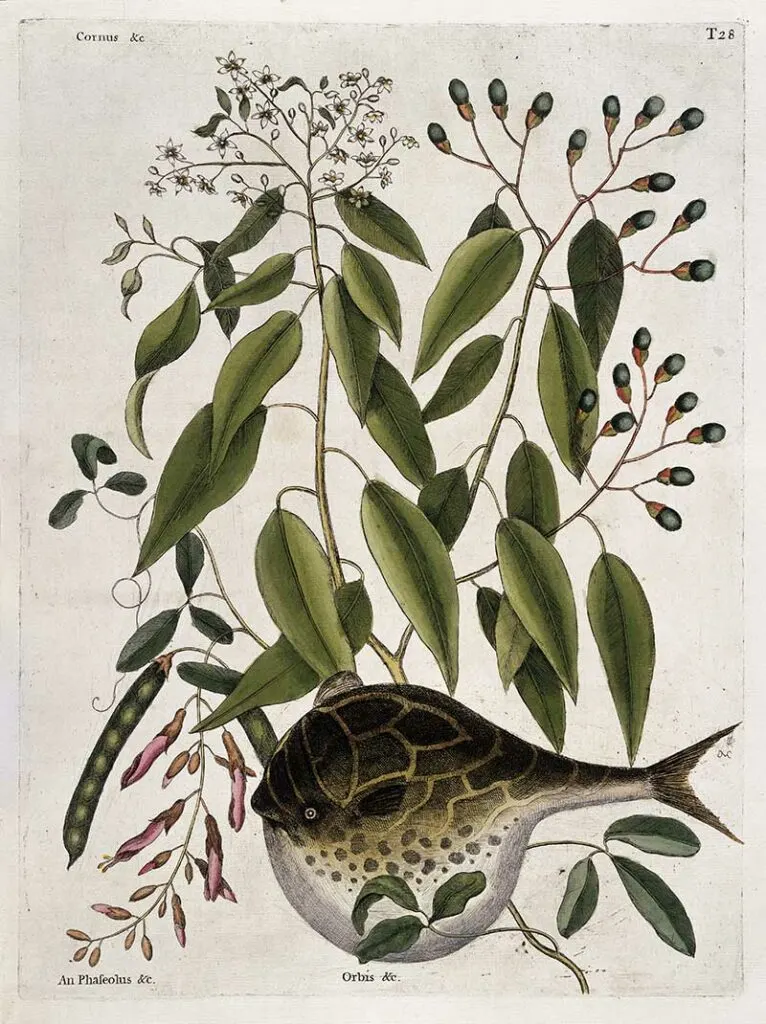
3. Large White Billed Woodpecker
An illustration of the large white billed woodpecker, perched on a winter oak tree complete with acorns.
(More American woodland tree prints can be found here).
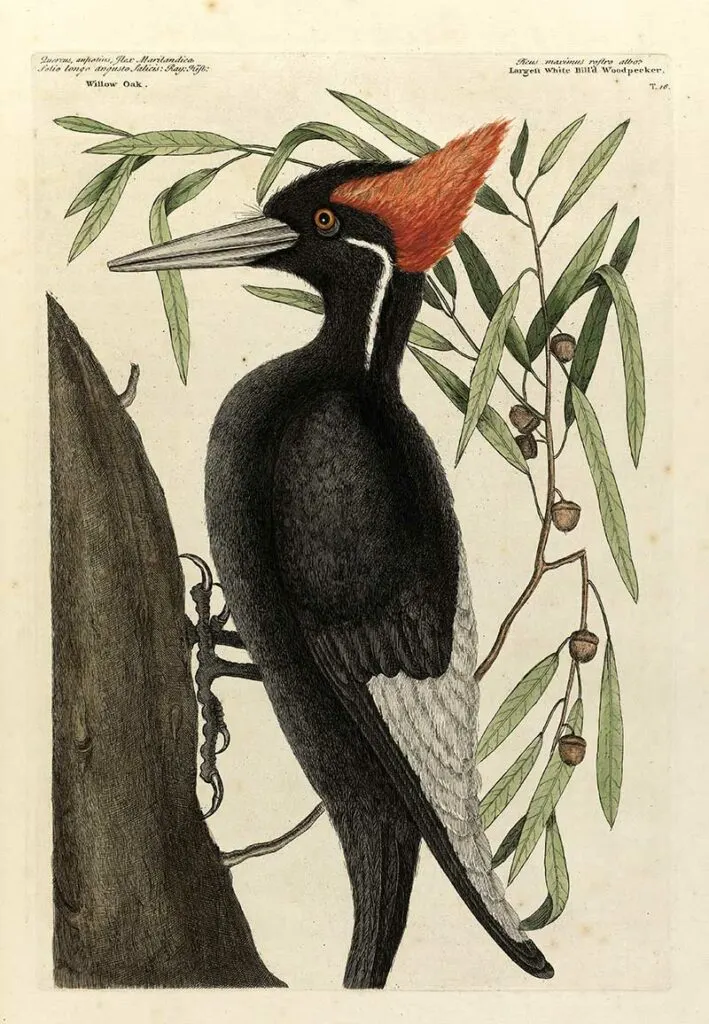
4. Green Tree Frog
A green tree frog (Rana viridis arborea) sitting on a leaf of Skunk weed (Arum Americanum) and about to lunge at a spider.
The frog is of bright grass green with two pale yellow lines extending the length of its body on both sides. Its eyes are large and black with a yellow circle around them. This frog is numerous in Virginia and Carolina and is mostly nocturnal.
You can find many more vintage frog illustrations here.
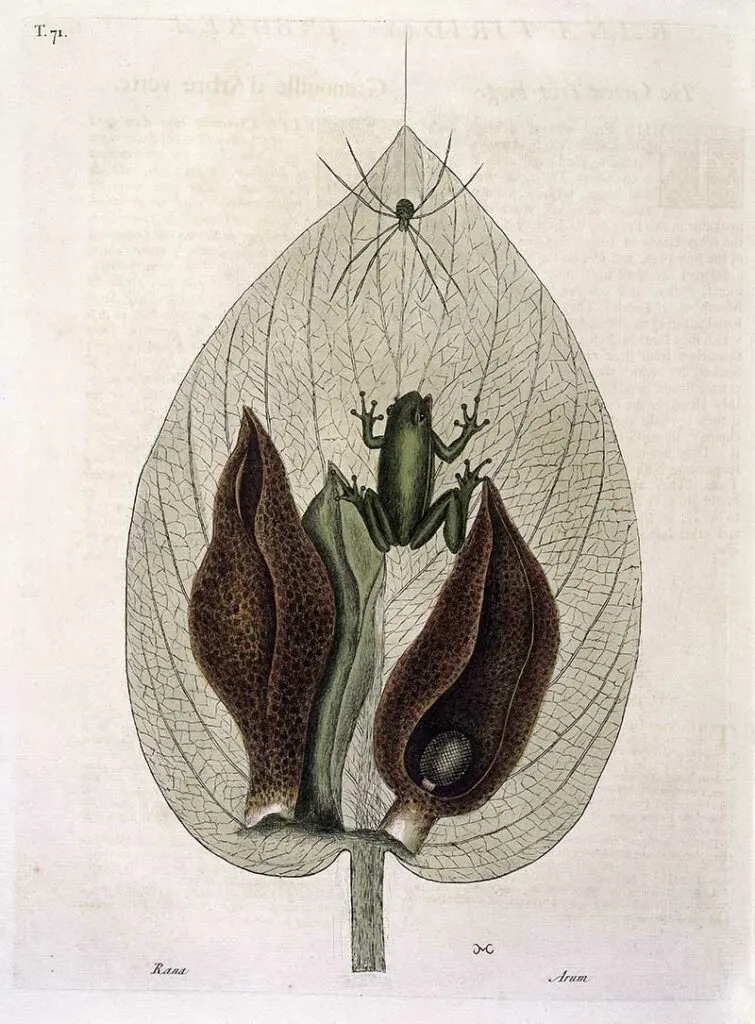
5. The Blue Heron
Mark Catesby prints: The Blue Heron (Ardea coerulea), breed in the Gulf states of the United States, through Central America and the Caribbean.
More beautiful heron paintings can be found here, including another version of this blue heron.
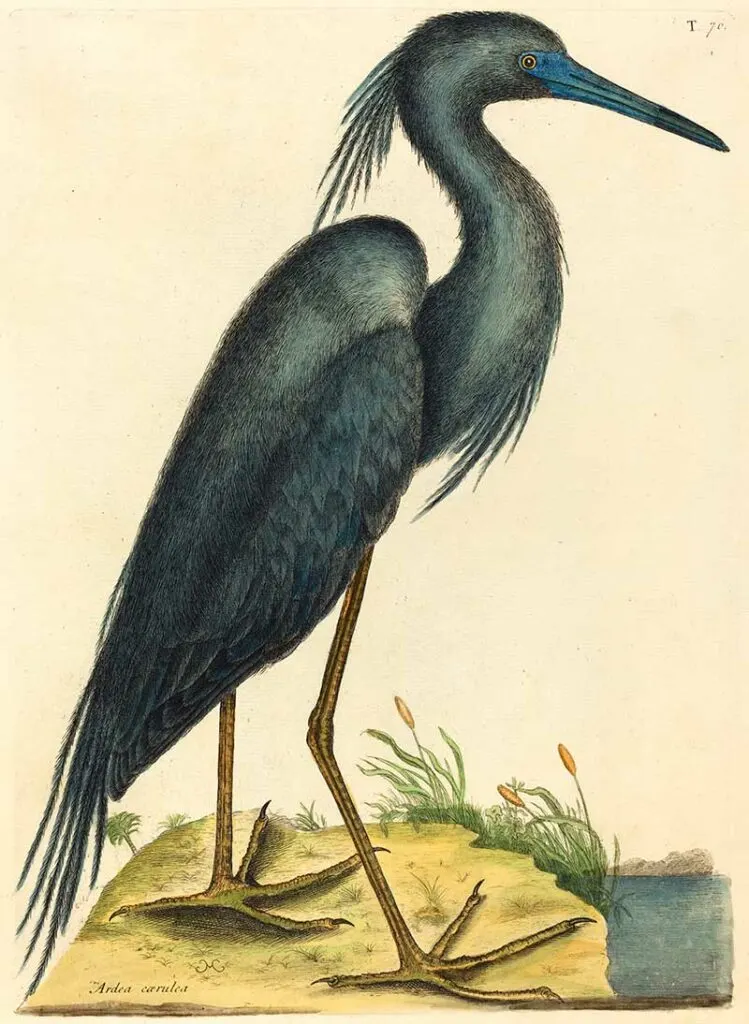
6. Laurel Tree
This is a beautiful illustration of this white Magnolia altissimo; I love the black background; it makes the beautiful white flower pop. Another Mark Catesby version of this vintage magnolia print can be found here.
Check out these other Renaissance flower prints in the Public Domain.
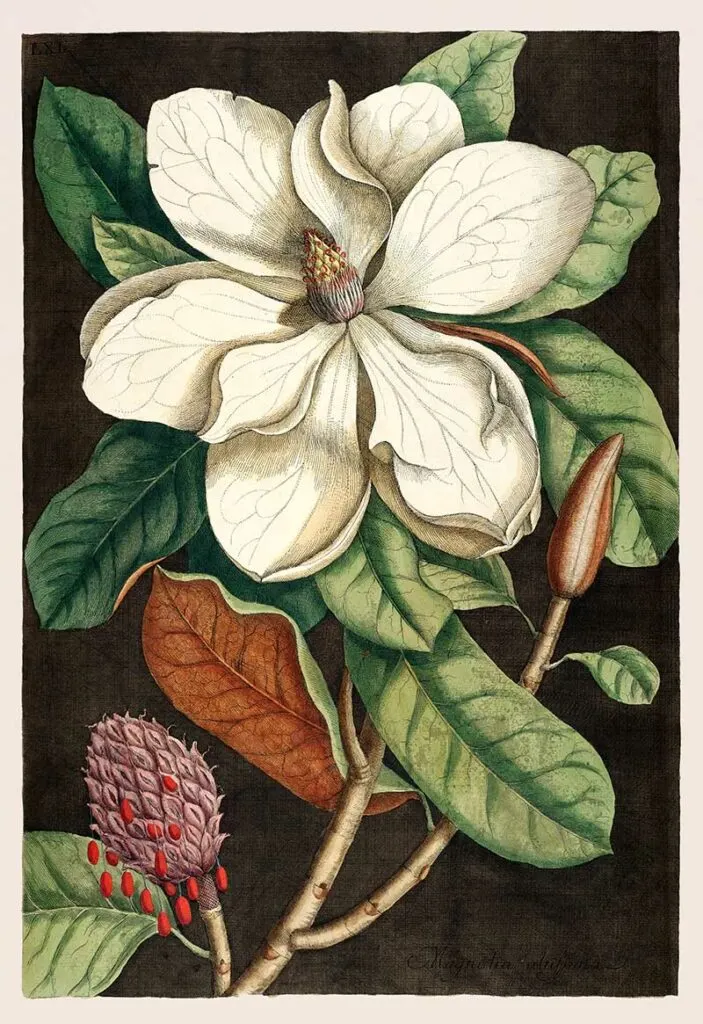
7. Land Crab
A vintage Illustration showing a land crab (Cancer terrestris =Gecarcinus ruricola) feeding on Tapia trifolia fructu majore oblongo plant. This crab is abundant in the Bahama Islands.
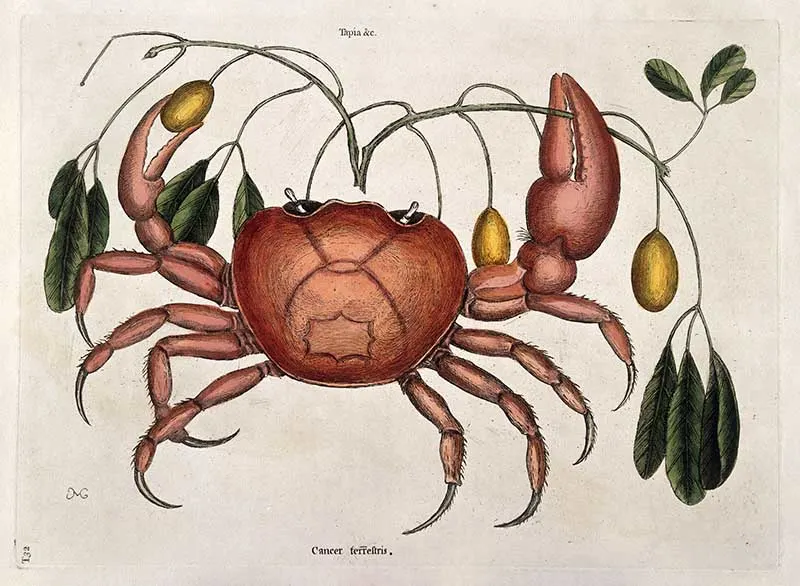
8. Great Hog-Fish
Mark Catesby print of the head and jaws of a Great hog-fish (Suillus). This fish was about 3-4 feet long. The iris of the eye is red, the upper mandible of a reddish-purple color and guarded by a bony substance as by a shield.
The upper part of the ‘shield’ to the eye is black; from under the eye to the angle of the mouth, it is purple sprinkled with crooked blue lines. The end of the upper mandible is armed with four large teeth; at the end of the under mandible were also two of the like size.
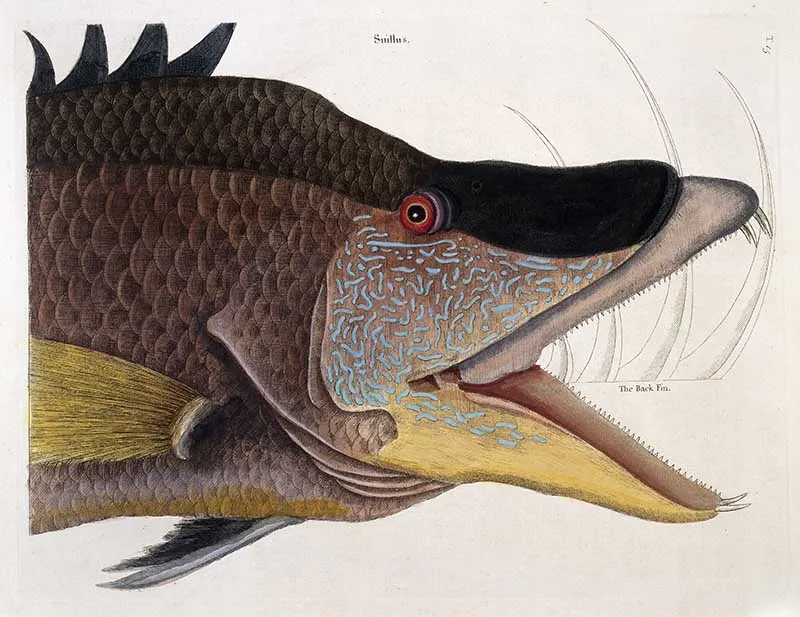
9. Plumeria Tree
A vintage illustration of the flower and leaves of the Plumeria tree. The flowers are tubulous and divided into five segments; they are of a rose color and very fragrant.
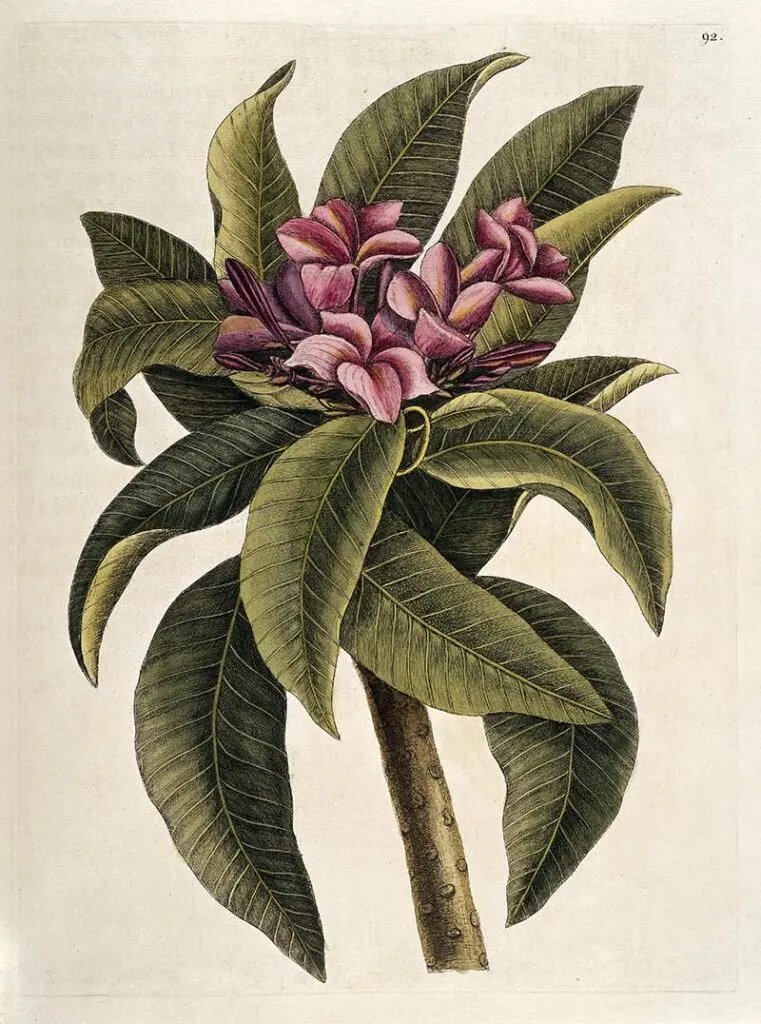
10. Orchid and Grey Squirrel
The Lady’s Slipper orchid, pictured with a grey squirrel.
You can find more vintage orchid prints here.
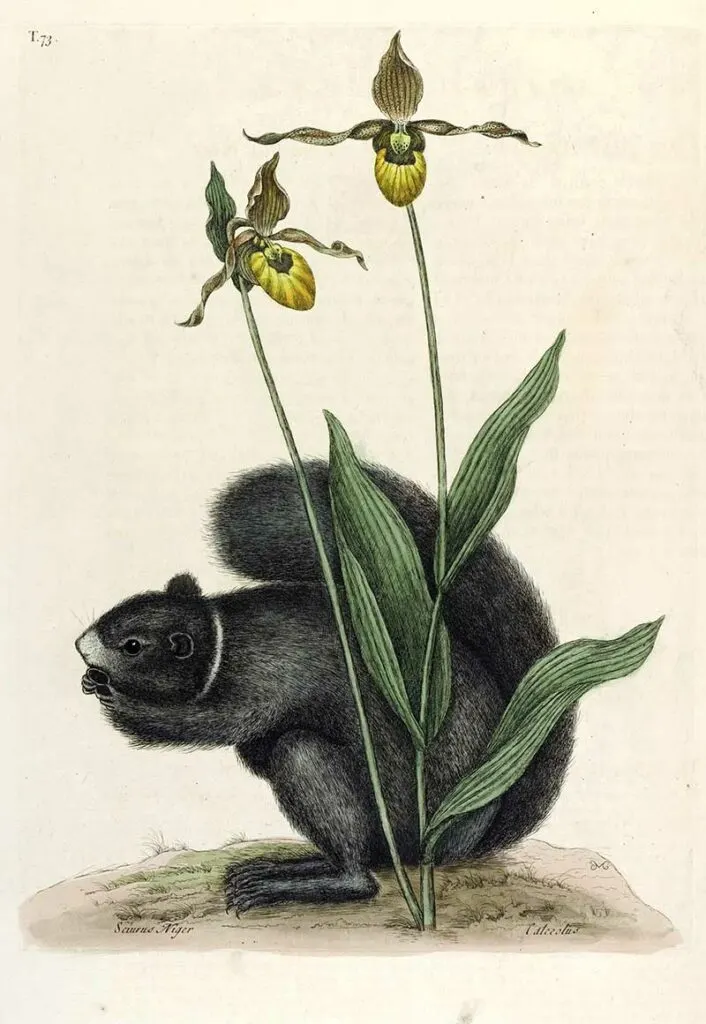
11. Summer Redbird and Western Plane Tree
The summer redbird is a medium sized American songbird.
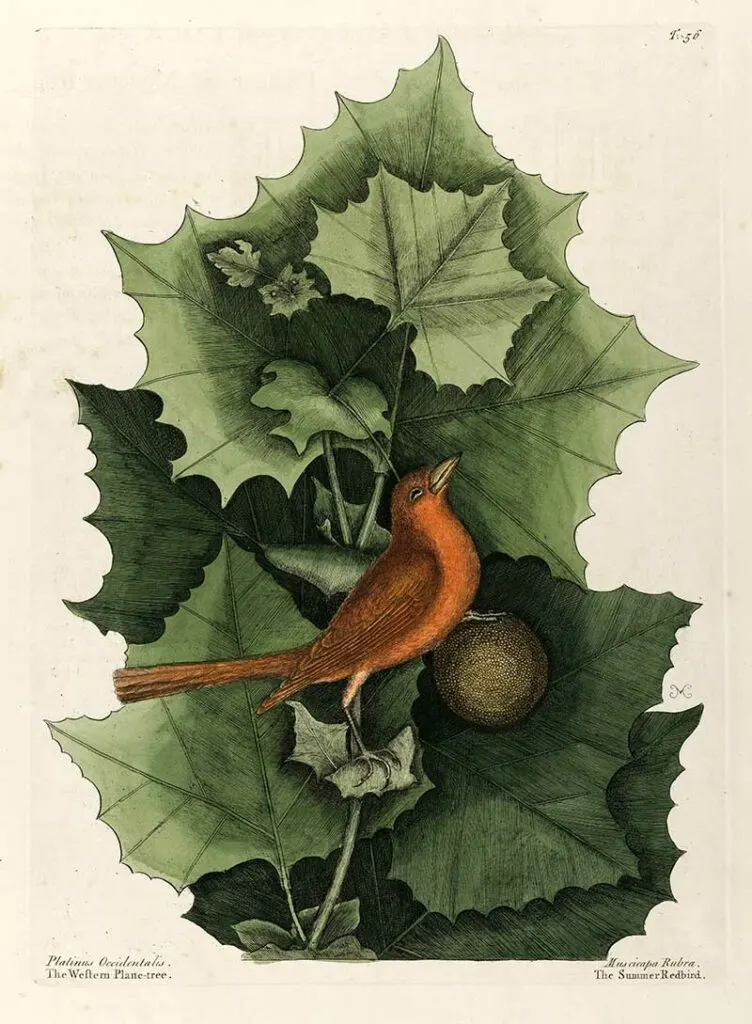
12. Red-headed Woodpecker
Another one of Mark Catesby’s woodpecker prints this time a Red-headed woodpecker perched on a branch of a Water oak.
The head and neck of this bird are deep red, all the under part of the body and rump being white, as are the smaller wing feathers. When the wings are closed, these join to the white on the rump and make a broad white patch across the lower part of the back, the upper part of which is black. The male and female are similarly coloured.
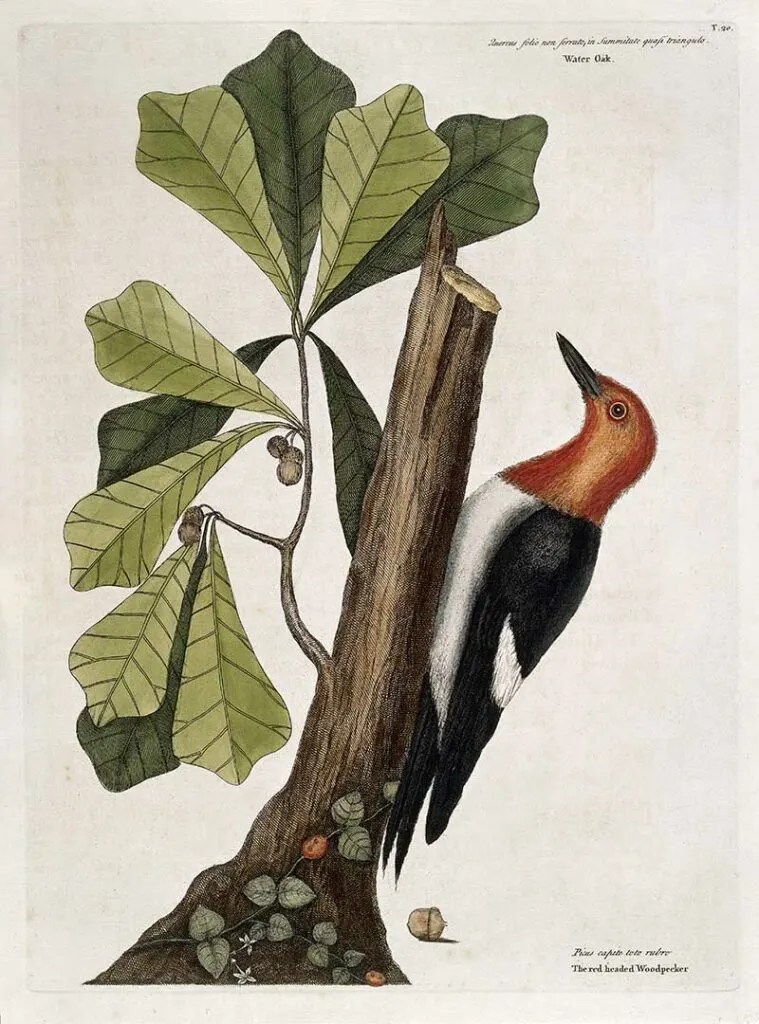
13. Sheep Laurel (Kalmia angustifolia)
This plant produces attractive small, deep crimson-pink flowers in early summer. Each has five sepals, with a corolla of five fused petals, and ten stamens fused to the corolla.
They are pollinated by bumble bees and solitary bees. Each mature capsule contains about 180 seeds.
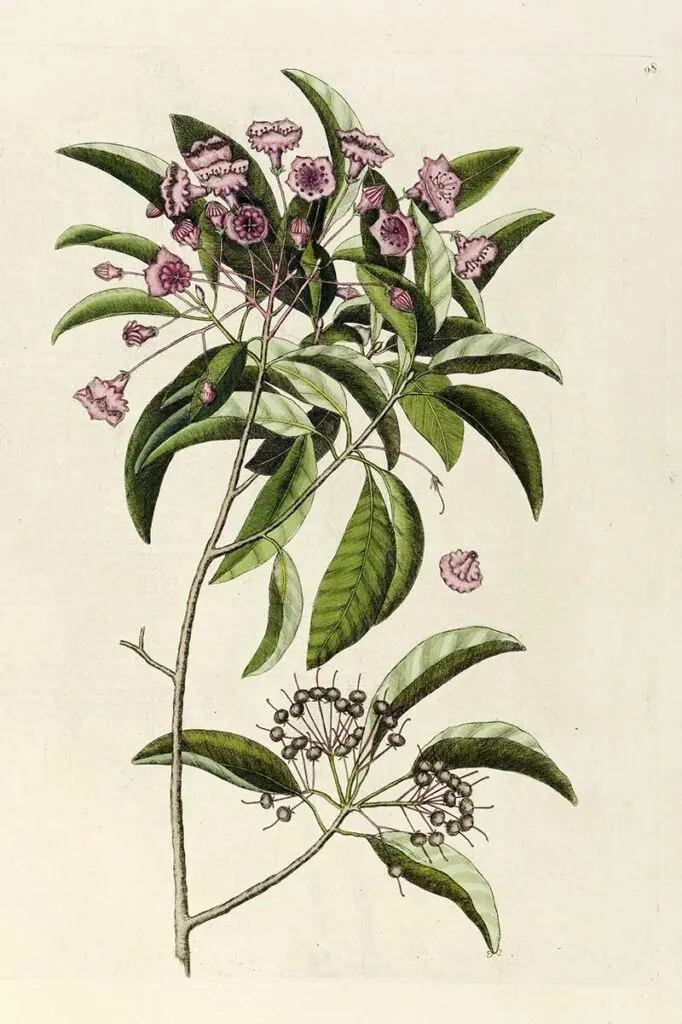
14. Bafterd Baltimore Bird
A Mark Catesby print of the Bafterd Baltimore Bird with the catalpa tree. Interestingly, the tree is the sole source of food for the catalpa sphinx moth, the leaves being eaten by the caterpillars.
When caterpillars are numerous, infested trees may be completely defoliated. Defoliated catalpas produce new leaves readily. Interestingly, fishermen grow these trees as they use the moth lava as bait.

15. Liquidamber and Lizard
Liquidamber trees are also known as sweetgum, are decorative deciduous trees that are used in the wood industry and for ornamental purposes.
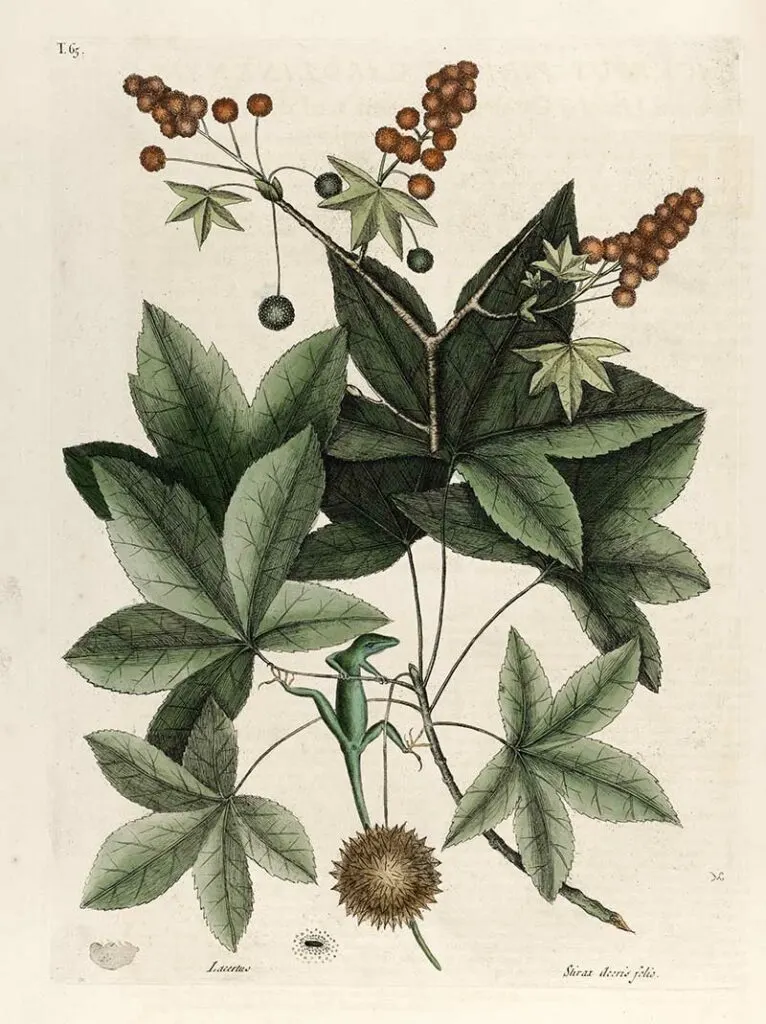
16. Balsam Tree
Balsam poplars are cultivated mainly in parks for their ornamental, light-colored bark and pleasant scent in spring.
Western balsam poplar is also planted as a timber crop. The wood is soft, very light in weight, but strong for its weight, coarse and fibrous, does not polish or plane easily, and is used for pallet boxes and other similar rough uses.
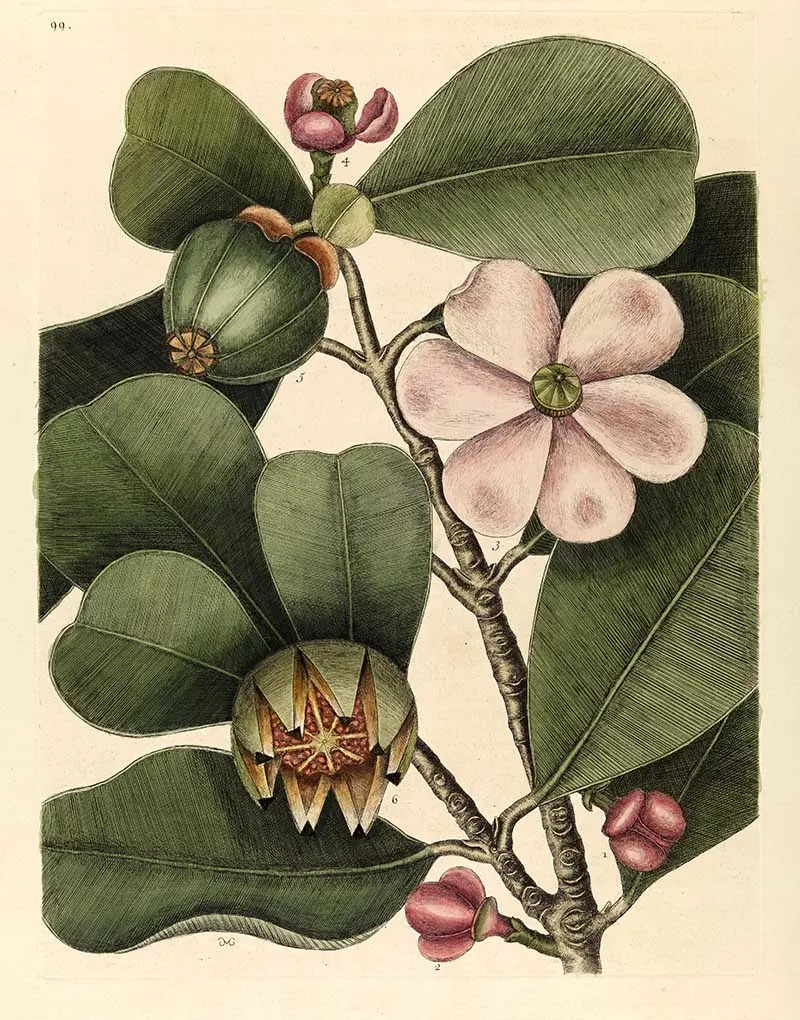
17. Flamingo With Keratophyton Plant
One of Mark Catesby’s most popular prints, a flamingo against a Keratophyton plant that grows in the shallow seas and channels of the Bahama Islands.
The flamingo attains its true color at two years, and then it is entirely red except for the quill feathers which are black.
There are many more wonderful flamingo art prints on Pictureboxblue.
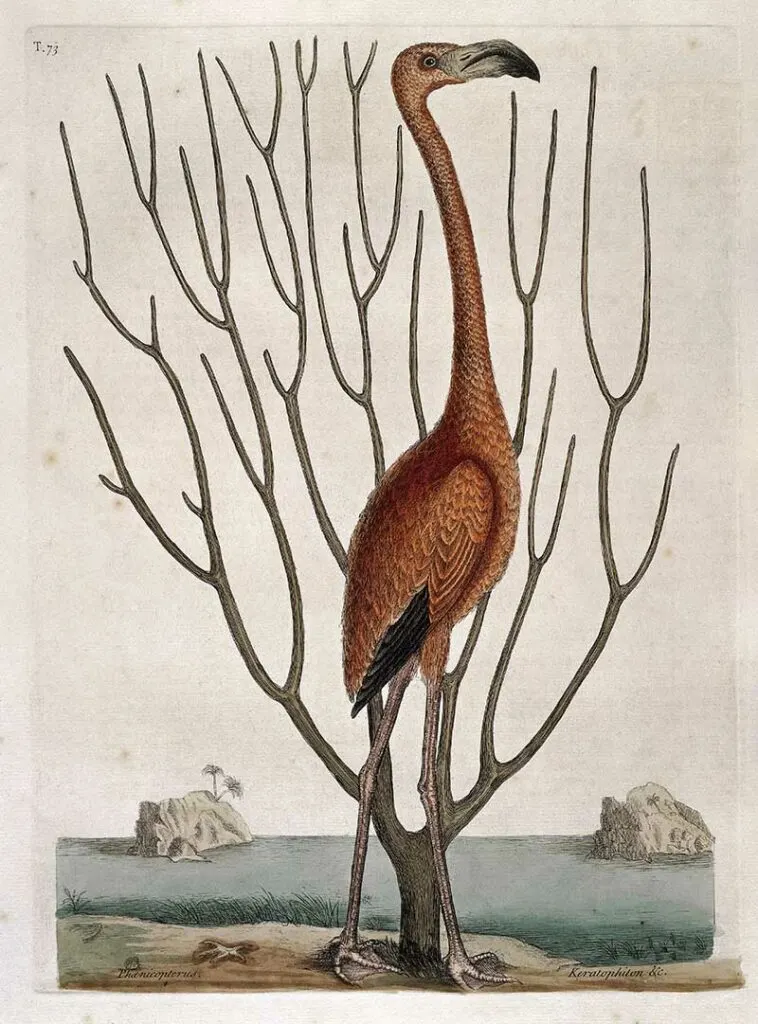
18. Parrot of Carolina on Cypress tree
Parrot of Carolina perched on a Cypress tree, from which it eats the seeds and fruit. This is the only parrot native to Carolina.
If you liked this parrot print of Mark Catesby then check out the amazing parrot paintings of Edward Lear.

19. Hog-nose snake with Martagon lily
A Hog-nose snake entwined around a Martagon lily. The crown of the snake’s head is back and brown with many large black spots, regularly placed; the hindmost parts of the body having transverse yellow bars between the black spots; the belly dusky white with smaller black spots.
There are some beautiful lily drawings and illustrations here.
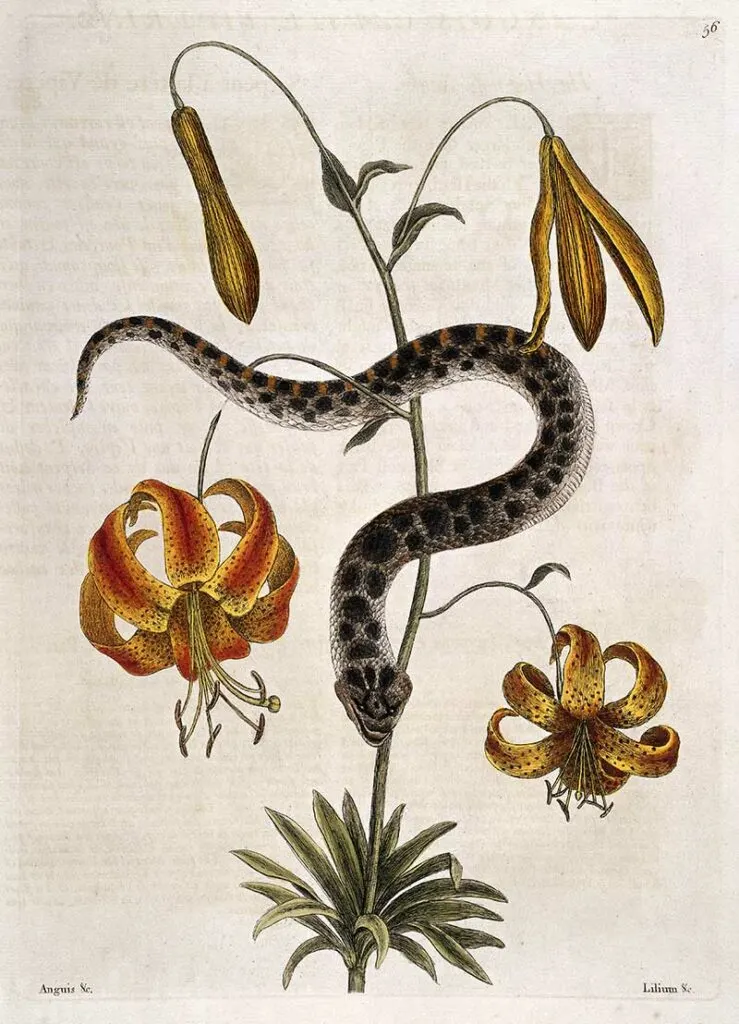
20. Mahogany Tree
Leaves, flowers, fruit, and seed pods of the Mahogany tree.
The numbered items are as follows:
- Flowers
- Cone beginning to open
- Cone opened, with its winged seeds
- Single seed
- One of the parts of the shell of the cone
- Core to which the seeds hang
- Plant of Mistletoe growing on the Mahogany tree.
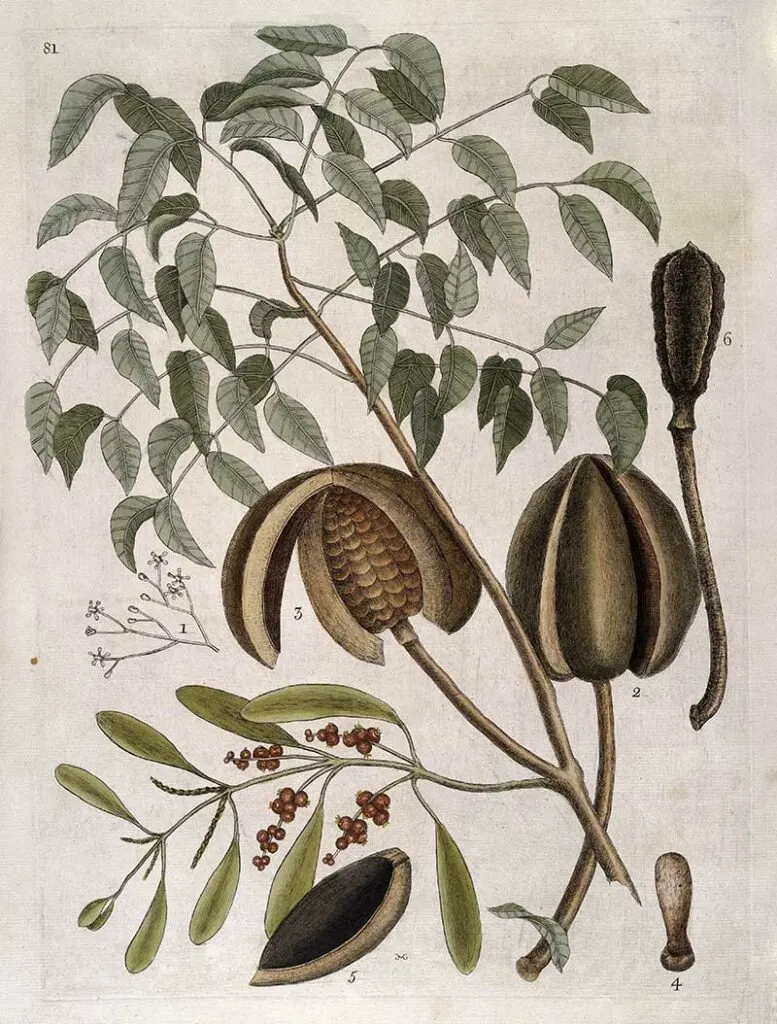
21. Bluish-green snake
Mark Catesby’s illustration of a bluish-green snake twined amidst a frutex baccifer verticillanus shrub, near Charleston, Carolina.
This harmless snake frequents the branches of trees, living on insects. They are green all over, inclining more to blue than yellow.
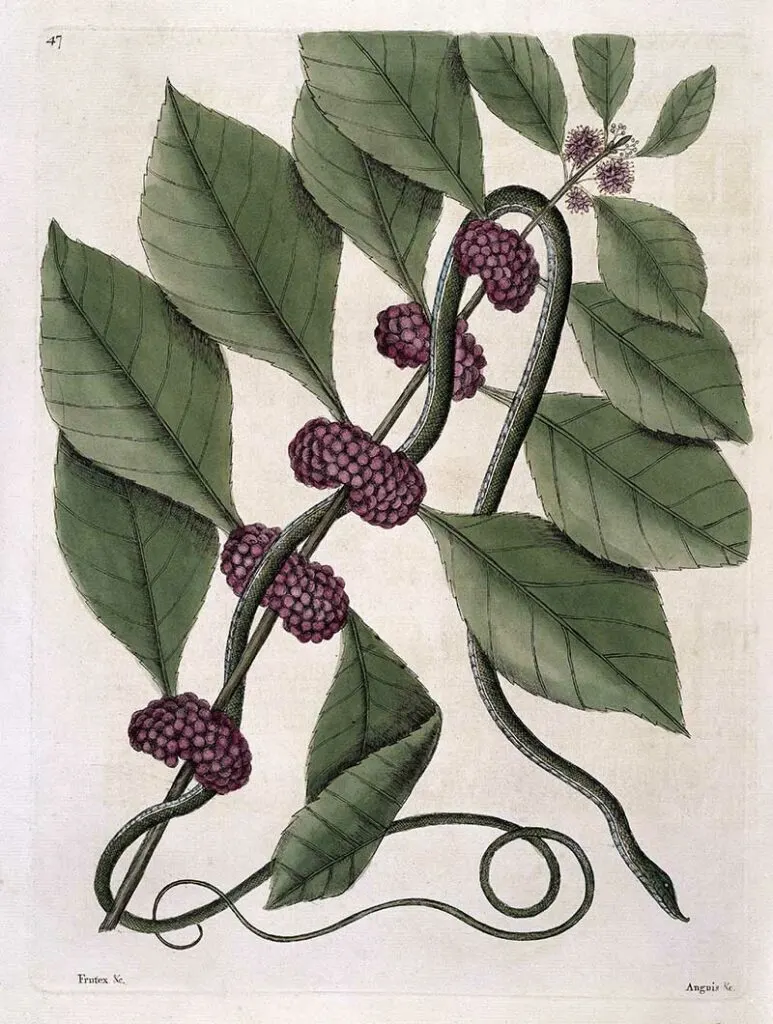
22. Humming Bird Feeding on Trumpet Flowers
A painting showing a Hummingbird (Mellivora avis Carolinensis) feeding from a Trumpet flower (Bignonia, fraxini folijs).
The bill of the Hummingbird is straight and black; the eyes are black; the upper part of the body and head of a shining green; the throat adorned with feathers placed like the scales of fish, of crimson metallic; the belly dusky white.
It receives its food from flowers, its tongue is a tube through which it sucks the honey from them. The bird breeds in Carolina and leaves at the approach of winter.
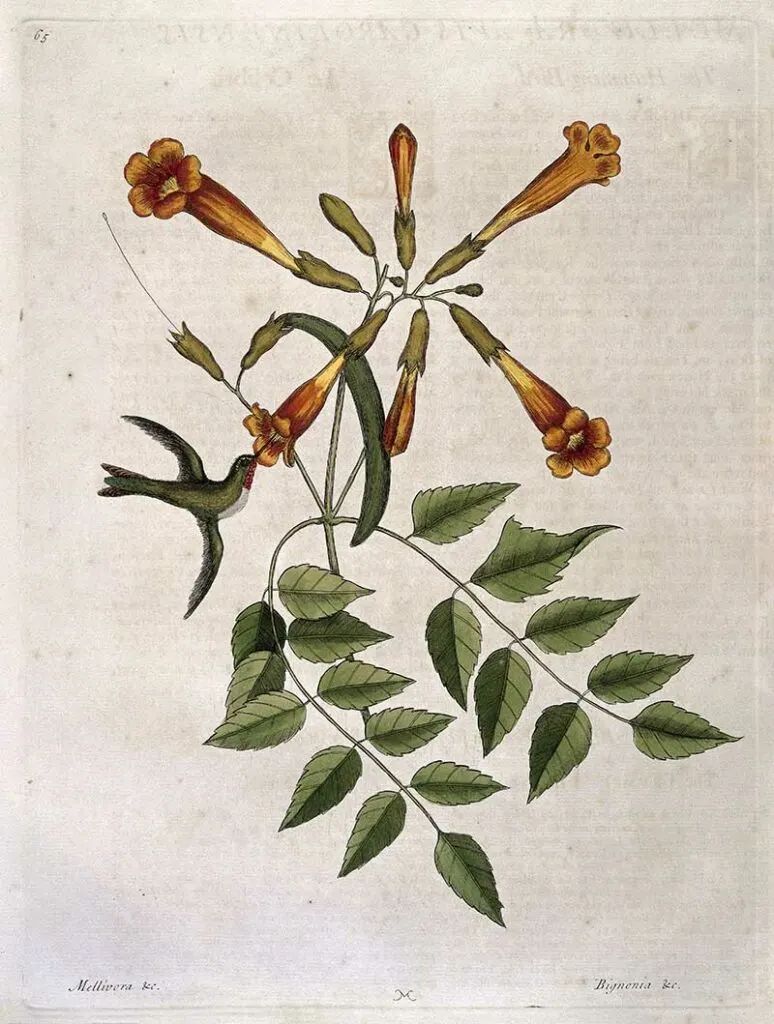
23. Black-cap fly catcher
A painting of a Blackcap fly-catcher perched on a branch of Yellow Jessamy. The bill of this bird is broad and black, the upper part of the head of a dusky black. The back, wings, and tail are brown, the breast and belly white with a tincture of yellowish-green.
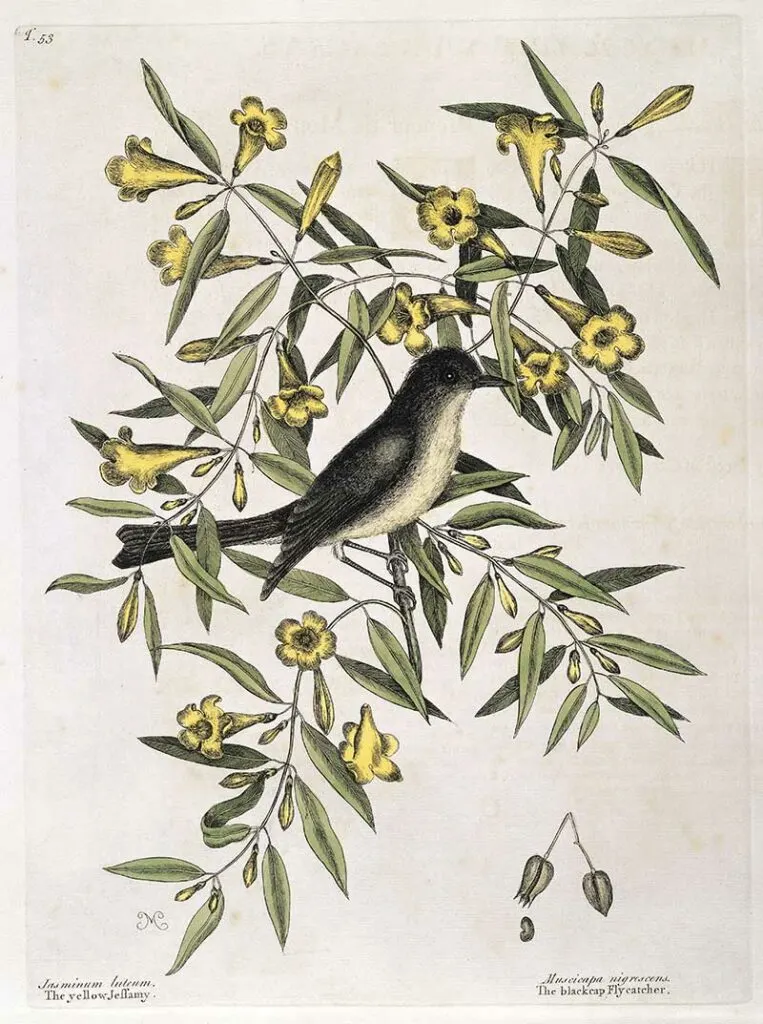
24. Blue Gross-Beak
An illustration of a male Blue gross-beak feeding on the seeds of the Sweet flowering bay.
The head and body of this bird, apart from the tail and part of the wings, are a deep blue. Below the shoulder of the wing are a few red feathers; the lower part of the wing and tail brown with a mixture of green.
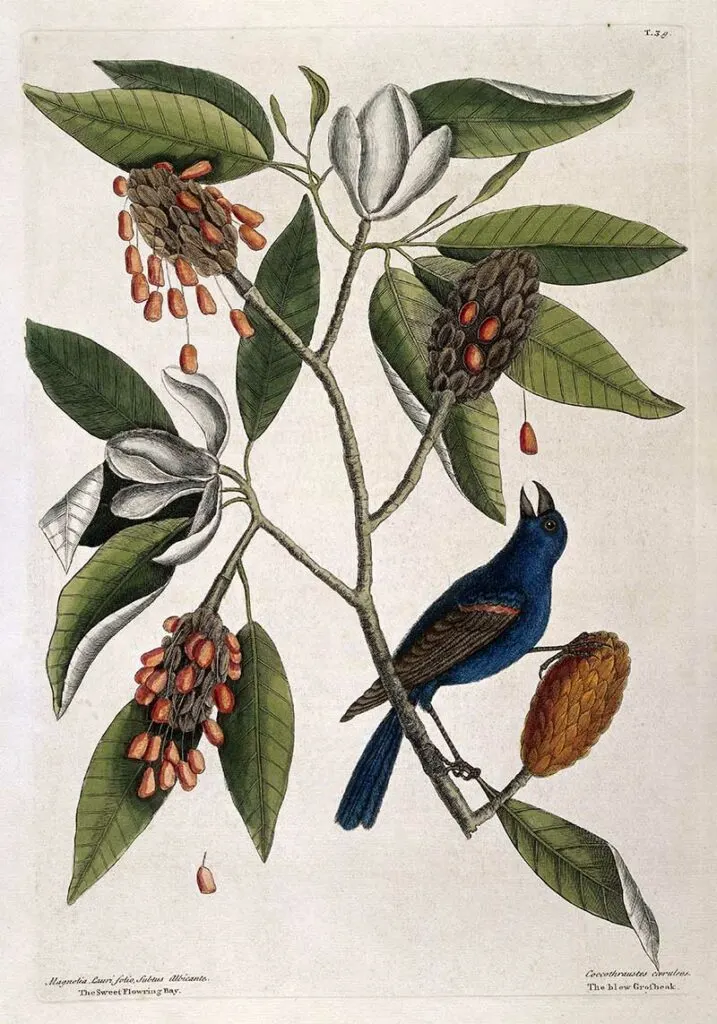
25. Gold Winged Woodpecker
A Gold-winged woodpecker perched on a branch of Chesnut oak. This bird is distinguished by the beams of all the wing feathers which are of a bright gold color. On the hind part of the head is a large scarlet spot.
It differs from other woodpeckers in the hookedness of its bill and manner of feeding, which is usually on the ground, out of which it draws worms and other insects. Neither do they alight on the trunks of trees in an erect posture as wood-peckers usually do.
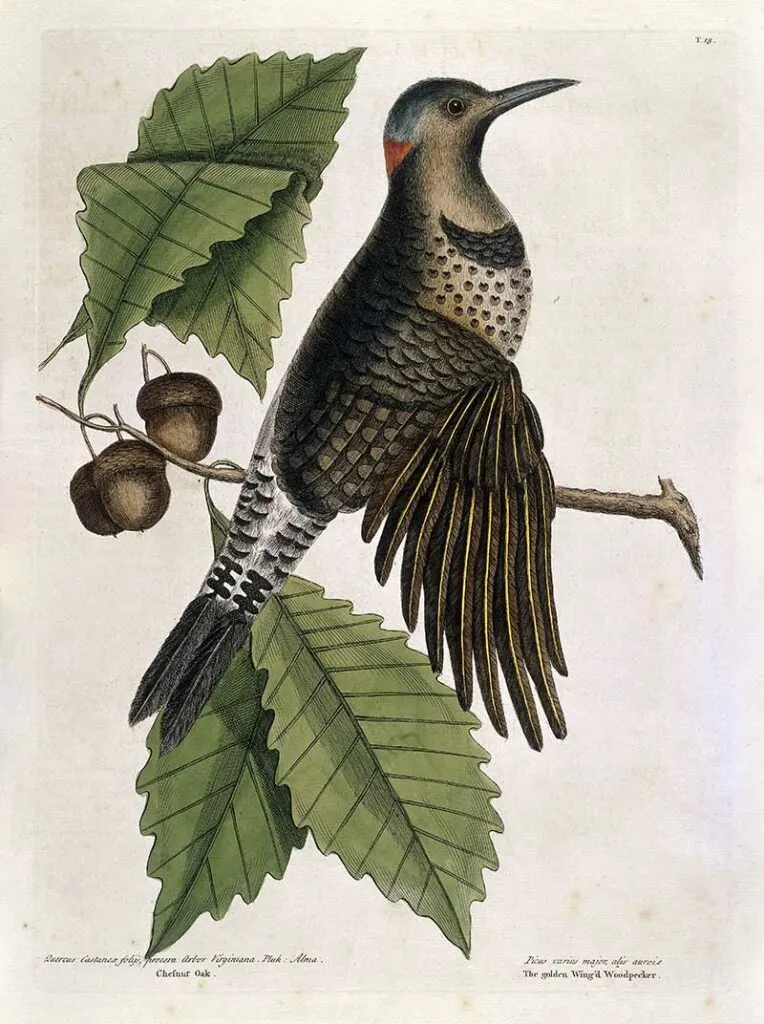
26. Flowering Dogwood And Mockingbird
Mockingbirds are best known for the habit of some species mimicking the songs of other birds and the sounds of insects and amphibians, often loudly and in rapid succession.
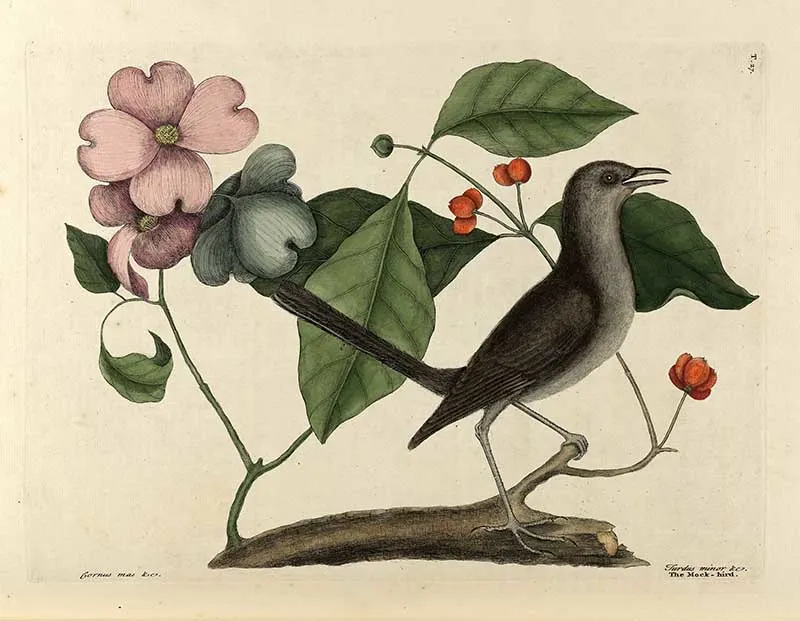
27. Little Black Bullfinch and Fringe tree
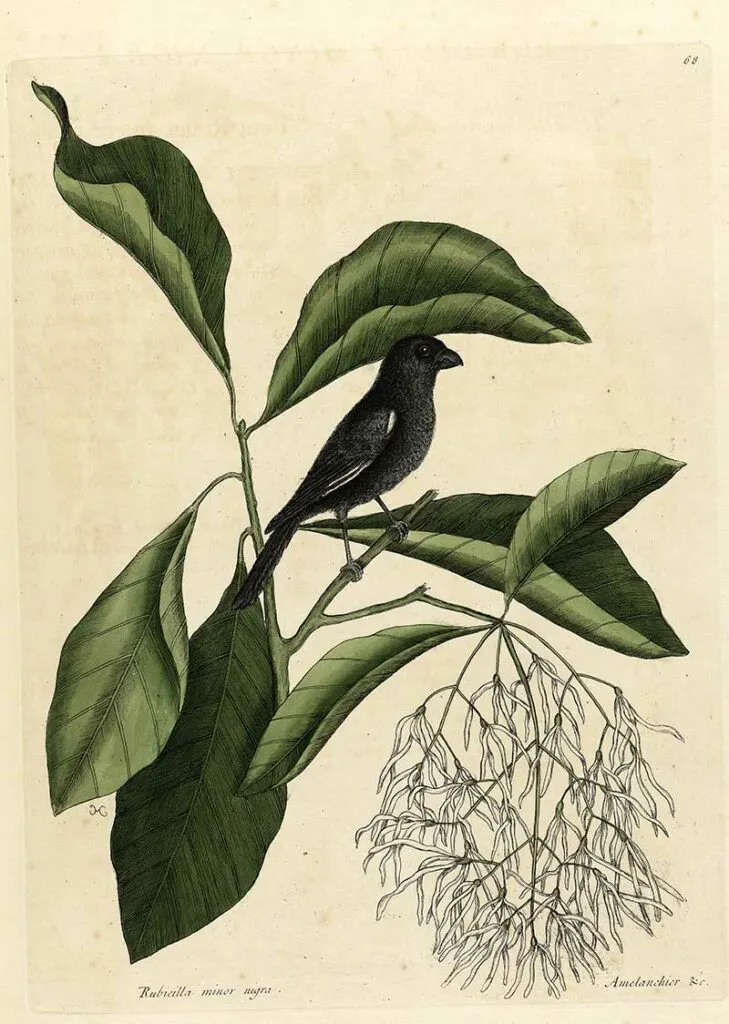
28. Baltimore Bird and Tulip Tree
I was lucky to see one of these gorgeous tulip trees in full bloom on a recent trip to the Royal Botanical Kew Gardens in London. They get their name because the tree’s large flowers superficially resemble tulips.
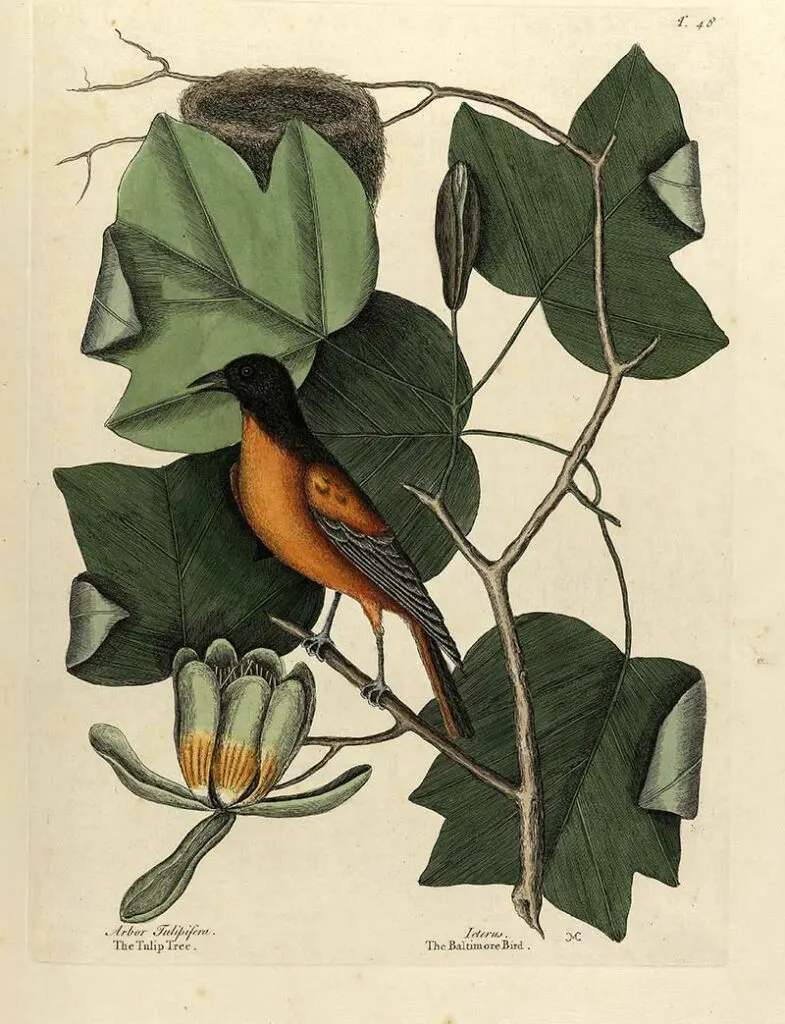
29. Umbrella Tree
Another one Mark Catesby’s beautiful prints on a black background. The name “umbrella tree” derives from the fact that the large leaves are clustered at the tips of the branches forming an umbrella-shaped structure.
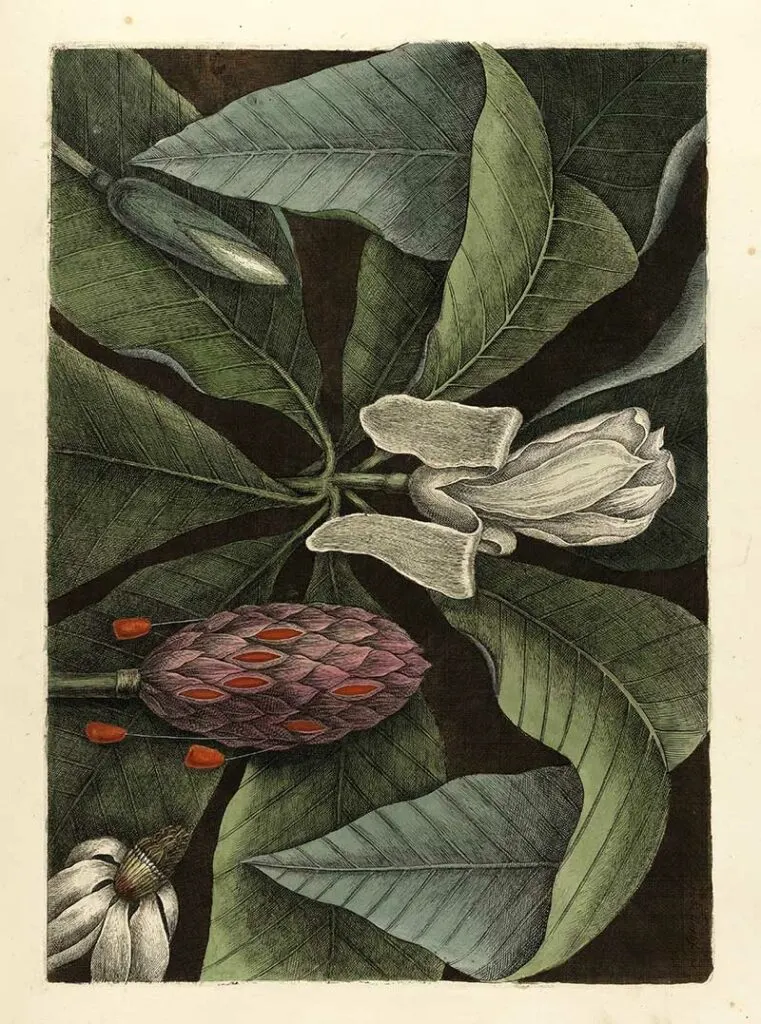
30. Snowbird
A Snowbird, a clump of Broom-rape, and a toadstool. The Snow bird’s bill is white, as is the breast and belly. The rest of the body is black. In Virginia and Carolina, the bird appears only in winter.
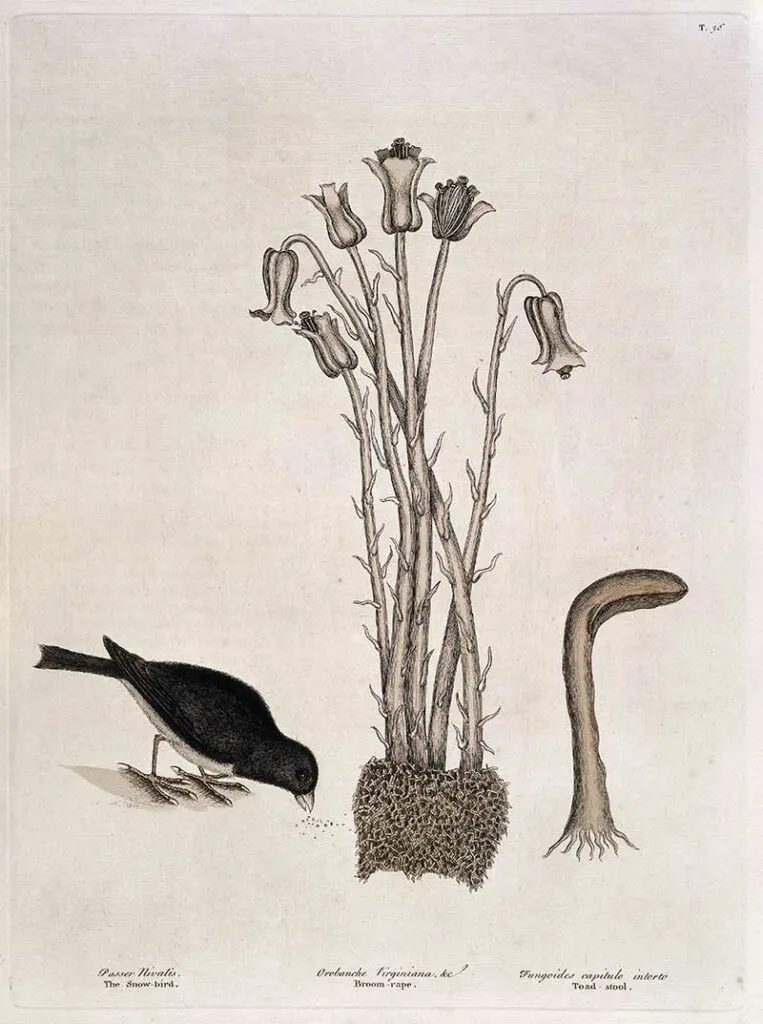
If you enjoyed these Mark Catesby prints don’t forget to check out some of my other popular vintage natural history illustrations on Pictureboxblue.

Ed
Tuesday 20th of July 2021
Claire. Thank you so much for posting all of these - they're fantastic. I've seen a number of other comments on here requesting that you start accepting donations and I insist that you must!
claire
Tuesday 20th of July 2021
Thank you, Ed. That is very kind but I'm just happy to share the images with others you appreciate them too.
Cecilia
Sunday 20th of June 2021
These are lovely! Thanks for sharing at Vintage Charm!
claire
Tuesday 22nd of June 2021
Thank you, Cecilia. I'm pleased you enjoyed them.
Allyson
Thursday 17th of June 2021
That was interesting reading the history of Mark Catesby art. My favorite is the Magnolia.
claire
Saturday 19th of June 2021
Thank you, yes I think the Magnolia print looks dramatic on the dark background it is beautiful.